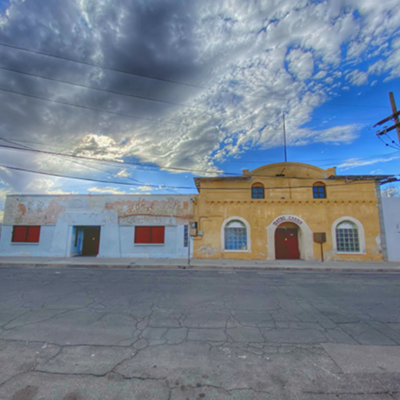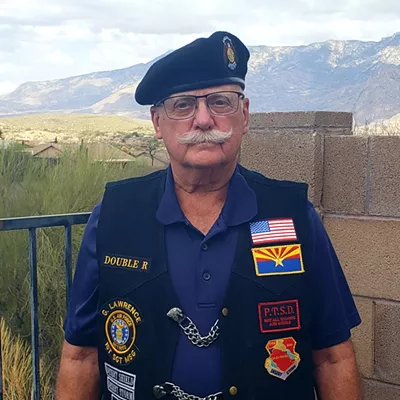Broadway Boulevard has undergone many transformations over time, from buggy path to pulsing midtown corridor. But as the old road preps for its latest metamorphosis, words keep mucking things up.
Or at least they did until recently, when the "functionality" demanded of the roadway design was released from its definitional straitjacket.
While the plow-and-pave crowd might consider this a step toward some touchy-feely, post-urban hell—complete with lilac-scented bike lanes and tastefully bedecked mommy stations—others see it as dragging us, albeit painfully, toward the 21st century of transportation.
Simply put, should Broadway become the eight-lane behemoth favored by Arizona's traditional asphalt boosters? Or might it be a roadway of the future, no wider than today, but chockablock with transportation alternatives, thereby not diminishing the road's functional ability to serve our needs into the horizon?
If the answers to those questions are a tad slippery, it's because the stakes are so high. As goes Broadway—smart, multi-use corridor or car-choked sea of asphalt—so might go all of the city's future big-ticket transportation projects.
Either way, the murk surrounding Broadway's future cleared a bit recently, with a fresh legal take on the permissible possibilities. In contention were varying interpretations of the long-range $2.1 billion Regional Transportation Plan approved by voters in 2006. That vote not only earmarked funding for projects such as Broadway, but also birthed a subagency called the Regional Transportation Authority to oversee them.
Ever since, the authority has repeatedly tangled with jurisdictions under its purview, including Pima County and the city of Tucson. Much of that squabbling has been attributed to longtime RTA chief Gary Hayes, whose brawling personal style reached a crescendo in 2010, when he chest-jabbed former Tucson City Manager Mike Letcher during a spat over Sun Tran buses.
Hayes stepped down late last year due to medical problems. With him went his stubborn opposition to any changes in the Broadway project from what voters approved in 2006. That ballot measure called for widening the roadway to six lanes, up from the current five, and adding two dedicated bus lanes, bike lanes and sidewalks.
But several members of a volunteer task force created to guide the project, along with neighborhood groups and some local officials, have envisioned a revamped roadway within the current alignment and width. Not only could this spare massive demolition, they argue, but it could also turn Broadway into a human-scale corridor not overwhelmingly devoted to cars.
Every time such notions are broached, however, the RTA not so subtly threatens to withhold its $42 million share of project funding. And those intimidation tactics inevitably center around the meaning of "functionality."
Now, tending to the "functionality" of every project—and more important, making sure it isn't squashed—is deemed a primary mission of the RTA's board. That board happens to include Tucson Mayor Jonathan Rothschild. And like the rest of us, it seems the mayor was a bit fuzzy on just what that niggling word might mean. So being an attorney himself, he asked another attorney—this one retained by the RTA—for a little clarification. Indeed he got it, sort of.
"I believe the answer we got is that we can change RTA plans so long as they create 'functionality,'" Rothschild writes in an email to the Tucson Weekly. "Then, conversation occurs about what is functionality in any particular case."
In a PowerPoint explanation to board members, RTA lawyer Thomas Benavidez explained that state law granted wiggle room to tweak projects here and there. "The purpose of the Legislature," he wrote, "in empowering the RTA Board to make changes ... without necessitating a public vote, was to ensure that the Board could react, efficiently, to changing circumstances ..."
Well, duh, says Tucson City Councilman Steve Kozachik, whose Ward 6 encompasses the Broadway project. Kozachik has long agitated for rethinking the whole shebang rather than just installing yet another eight-lane, 150-foot-wide behemoth—and swallowing up Broadway's thriving north-side businesses in the process.
"The words '150 to the north' were etched on Moses' stone tablets before now," Kozachik says. "I guess Moses dropped one of the tablets and they re-etched them and came up with some new language."
The councilman isn't alone in relishing more flexibility, particularly since the eight-lane scheme comes from badly outdated traffic studies. Pima County Administrator Chuck Huckelberry also favors a little leeway—to a point. "I'm comfortable with it until someone says you don't need to widen Broadway," he says. "My view is that six lanes and strategic bus pullouts can probably do the same thing as eight lanes. But there are probably a few folks who think you can wave a magic wand and make four lanes OK. And that's not the case."
Then again, flexibility isn't for everybody. Just ask Laura Tabili. She's a member of the Broadway Coalition, which opposes stretching the roadway to eight lanes. Late last month she attended a meeting of the RTA's advisory body, known as the Citizens Accountability for Regional Transportation, or CART committee, where she says the "chiseled-in-stone, 'we've got to stick to the ballot' people were extremely vociferous. And I think they intimidate other people on the committee from saying what they really think."
Jim DeGrood is the RTA's transportation director. He says the CART committee is rich with divergent viewpoints, "and I know people would like to characterize us in various ways." But he points out that the RTA board itself "took a pledge not to diminish functionality. They understand that the public is voting on this passage and they're looking at very specifically scoped projects and pledge not to, over the course of the project, diminish functionality."
Pledges, smedges. In these loosey-goosey days, there's even chatter about weaving Broadway back and forth, thereby dodging significant historic buildings. But threading that needle brings its own set of problems, such as the 39 properties already bought by the city as right of way along Broadway's north side. Many, such as the Panda Buffet, remain empty in suspended, if decaying, animation. Meanwhile, business owners to the south might be surprised to learn they're also in the cross hairs.
But that's jumping the gun, says Jenn Toothaker Burdick, the city's Broadway project manager. "I would hate for south-side businesses to be concerned at this point," she says. "Ultimately what we're shooting for is to have the least impact as possible. We're looking at the north versus south as mutual benefit, win-win situations."
In the meantime, Toothaker Burdick is all for the new flexibility in functionality. "We absolutely respect that voters have voted on a project," she says, "but we absolutely feel that there might be an intent behind a project that (becomes clear) when it comes time to implement."
Functional flexibility, fully implemented. Now we're talking.









